Tradition, change shape cuisine and people from Gjakova to Zllakuqan.
Gjakova
When I set out to explore Western Kosovo, I knew my first stop had to be Perparim Babalija. In the San Francisco Bay Area, where I come from, Babalija could easily be cooking for crowds of twenty-something foodies willing to put down at least $50 a head to sample the latest culinary frontier, Albanian fusion. Babalija, 31, is a long way from the West Coast of the United States, in Gjakova, where his twists on traditional Albanian cuisine would appall many.
I visited Babalija at Allorja 1, his family restaurant on the edge of the old town, where he cooks in two different worlds. Most of the time Allorja 1 functions as a classic kebab house, or qebaptore, where customers stick to a simple, satisfying menu of grilled meats little different to any others across the country, or the region. But Babalija also uses the little kitchen to push the limits of traditional Albanian cooking, infusing what he learned at culinary school in France and Poland into traditional staples. These meals require making special arrangements in advance.
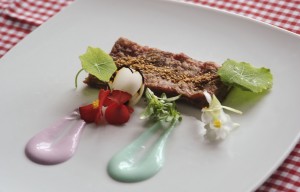
A traditional dish is transformed into a work of modern art. | Photo: Atdhe Mulla
For the first lunch course he prepared qofte, transforming a traditional flattened minced-meat kebab into a work of art. He garnished the meat with white sesame seeds and plated it with begonia and nasturtium flowers, wild basil and onion and two sauces, one made from blue curacao liqueur and the other with red beet. “It’s all edible,” he said, before I tried a piece of meat with a flower petal. (It added a nice citrusy touch.)
“People need this cuisine. They just don’t know it yet.” Perparim Babalija
The ingredients, largely sourced locally, added layers of complexity without overwhelming the qofte. It was something that a lot of people in Kosovo would actually enjoy if they were ready for it.
“People need this cuisine. They just don’t know it yet,” Babalija said.
The ad-hoc nouveau Albanian restaurant-within-a-restaurant concept would also do well in San Francisco, but Babalija would rather work in a proper kitchen of his own. He frequently works in Albania, where palates are more adventurous and restaurant owners more willing to invest in what happens in their kitchens.
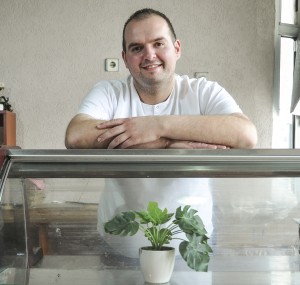
Chef Perparim Babalija is redefining Albanian cuisine at his family’s kebab restaurant in Gjakova. He makes things like qofte with wildflowers. | Atdhe Mulla
“We’ve never loved chefs in Kosovo. The problem is that good ingredients and chefs are expensive. So chefs are typically forced to do the work of three people,” Babalija said.
So far, Babalija hasn’t found the right opportunity in Kosovo but hopes it will happen eventually. “I’ll serve three types of cuisine: bio, molecular and seasonal,” he said.
It seems appropriate that Babalija is from Gjakova, a place reputed to produce quirky, successful people – and, seemingly, a disproportionate number of restaurant and bar owners in Prishtina.
It’s the kind of place where it makes sense to order a shpricer, which I learned from my Gjakovar friend Eldita Tarani, 28, is a mixture of boza — a thick fermented grain drink, mostly consumed by old men and pregnant women in the Balkans — and lemonade. I had one after lunch at a pastry shop in the city center called Sharri, where a display case included an assortment of syrupy Turkish desserts and eclairs. “This place hasn’t changed since my childhood,” Tarani said.
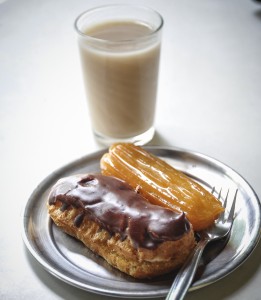
Not much has changed at the Sharri pastry shop. Classic desserts are served alongside boza. | Photo: Atdhe Mulla
I’ve never really cared for boza. It reminds me of a sludgy, sweet cousin of beer and doesn’t have much discernible alcohol. Combined with lemonade, I now discovered, it becomes rather refreshing. It also paired well with the chocolate eclair and helped wash down the second and final course served by Babalija, beef liver rubbed with wild basil.
After dessert, Tarani took me to Cabrat, an affluent neighborhood in the hills above the town. We parked near a monument to partisan fighters who died during World War II. Done in the style of a small amphitheater, it’s gated off and crumbling, one of those forgotten pieces of Kosovo’s Yugoslav past. In its shadow, a chic cafe and cocktail bar called Index offers stunning views of Gjakova.
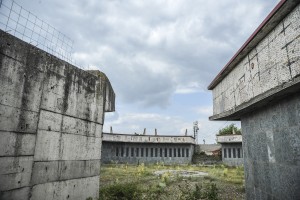
A monument to partisan fighters who died during World War II. | Photo: Atdhe Mulla
Tarani’s father, Elmir, 59, joined us. Elmir is a physician, and, I discovered, a music expert whose extensive record collection is now 2,000 strong. He also was able to sell records to make ends meet during the hyperinflation that hit Yugoslavia in the 1990s. He fondly recalled how the town used to have small speciality food shops, including one devoted to kajmak, the Balkan version of clotted cream. He also talked about the harder times, about how Gjakova was targeted during the 1998-9 war as a center of Albanian nationalism, only to face problems after the conflict because of a perception that it had been a hotbed of communist support, and by virtue of that, sympathetic to the Serbian regime.
“We’ve had lots of pressure from both sides,” Elmir said.
Allorja 1 is located near the Taliqi Bridge on the edge of Gjakova’s old town. Contact Babalija to arrange a visit: +37744 735 235 or Facebook.
Junik
Twenty kilometers northwest of Gjakova, Junik is one of the few towns in Kosovo where there’s still a palpable sense of history dating back centuries. It is possible here to spend the night in a bona fide kulla, a defensively fortified stone house.
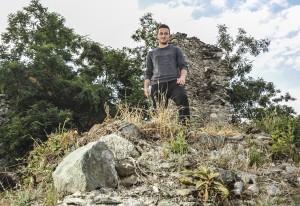
Bajram Tofaj, 21, stands on the ruins of an old kulla house below. The village of Zllakuqan, near Klina, is predominantly Catholic. | Photo: Atdhe Mulla
On a Saturday evening, on a road above the town center, men were congregating around a small market before iftar, the nightly meal held during Ramadan to break the fast. Bajram Tofaj, 21, a student at the University of Prishtina, was home for the weekend. As he attempted to offer his thoughts about life in Junik — “quiet and surrounded by nice nature” — old men provided friendly heckling. “You chose the prettiest boy in Junik to talk to,” one yelled.
Up the street, relatives of Tofaj own what they claim is a 500-year-old mill, powered by the force of the Erenik river. It was still in use until 2007, when people stopped bringing their corn to be ground into flour. More impressively, a makeshift hydroelectric generator is theoretically functional.
Niman Tofaj, 69, a grandfatherly man in a gray suit and sunglasses, explained how he set up the generator during the 1990s when the power supply was especially erratic. “I struggled a little bit at first but eventually it came together,” he said.
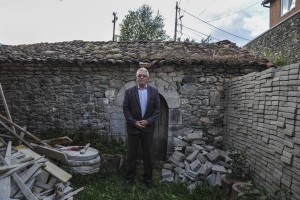
Niman Tofaj, 69, built a small hydroelectric power generator in his family’s centuries-old mill in Junik during the 1990s. | Photo: Atdhe Mulla
Tofaj was born in Junik and recalled that when he was a boy people still wore traditional Albanian clothing, now only usually seen in folk dance performances.
“Life has changed for the better, but we don’t have the same kind of happiness that we had back then,” he said. “Junik has changed drastically.”
Zllakuqan and Istog
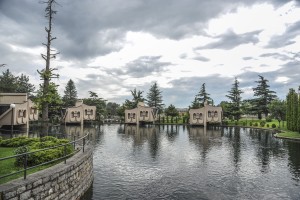
At the Trofta complex in Istog you can fill your belly with locally farmed trout and spend the night in a waterside bungalow. | Photo: Atdhe Mulla
It’s often said that the “religion of Albanians is Albanianism,” reflecting that while Albanians are of different faiths — mainly Muslim, Catholic and Orthodox Christian — national identity is the glue that holds them together. While that is true, religion still makes distinct imprints on Albanian culture, including on food and drink.
“Here in the Drini valley, every family has a reserve of 30 liters of rakia and some pork bacon or pastrami,” said Ilir Kolaj, the manager of Astro, a restaurant in Zllakuqan, a mainly Catholic village near Klina.
Religion makes distinct imprints on Albanian culture, including on food and drink.
Astro does not serve any pork, though Kolaj said that competitors in surrounding villages had spread false rumors that their chicken was cooked in pork fat. “It’s 100 per cent sunflower oil,” he said.
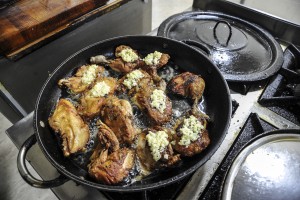
The fried chicken at Astro in Zllakuqan takes hours to make, and the results are delicious. | Photo: Atdhe Mulla
The chicken served in this otherwise unremarkable roadside restaurant was unlike anything I’ve ever had in Kosovo. It was deep fried without any coating and then topped with mounds of garlic, and balanced out with a yogurt sauce on the side. The result was sort of like roasted chicken but more tender and delicious.
Making the chicken is labor-intensive and takes hours, Kolaj said. The chickens are first boiled and chilled before they’re fried. “It’s a very expensive process,” Kolaj said. “We don’t really make any money on the chicken – that happens with the drinks.”
A half-chicken costs 2.50 euros, so “it’s affordable for everyone, from construction workers to ministers,” he added.
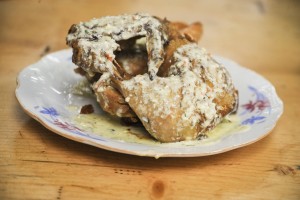
Chicken at Astro. | Photo: Atdhe Mulla
Astro began as a small drinking establishment in the 1970s. Food was gradually added to meet the demands of the drinkers. Chicken was only added to the menu after someone asked for it. The first chicken came from the backyard, Kolaj recalled. These days, they come from Switzerland because chickens from Kosovo are not consistent in size.
After the meal, Kolaj insisted on pouring me a rakia, made in the village.
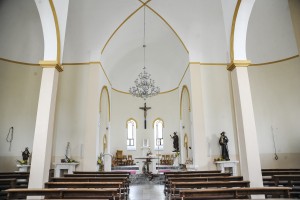
The village of Zllakuqan, near Klina, is predominantly Catholic. | Photo: Atdhe Mulla
“I love the rakia so much,” he said, pouring himself a glass. It was made by a neighbor, aged for a year in a barrel made from mulberry wood.
The rakia produced in the area largely comes from plums, which is uncharacteristic of Albanian parts of Kosovo, where it’s usually made from the pomace of grapes. The rakia e kumbulles at Astro was smoother and lighter than most of the sljivovica I’ve had in Serbian communities, which can hit drinkers like a punch to the face.
Kolaj informed me that there is something of a rakia crisis brewing in the area because the last plumb yields were disappointing. Luckily for Kolaj, who claimed to drink about a liter of the stuff each week, he hasn’t had to tap into his personal reserve yet.
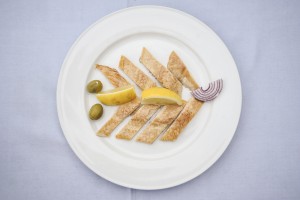
Fresh fish at the Trofta complex in Istog. | Photo: Atdhe Mulla
Astro in Zllakuqan is located six kilometers northwest of Klina, on the road to Istog, on the right side. Contact:+377 44 235 230.
Isniq
Some 40 years have passed since the late Norwegian anthropologist Berit Backer lived among the people of Isniq, near Decan. Her Master’s thesis, “Behind Stone Walls,” submitted in 1979 and published as a book, posthumously, in 2002, concluded that the traditional values and family structures would be challenged in the modern world.
I drove into Isniq on a Sunday evening at dusk. Like Junik, it is a place that still has visible links to the past with its kullas and homes hidden behind high walls. In the town center, I chatted with three young men milling about outside a bakery, Uran Tahirsylaj, Arian Imeri and Elton Osdautaj.
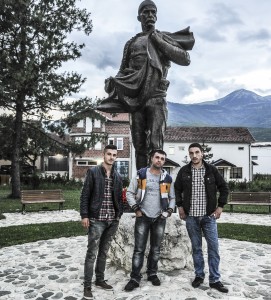
Arian Imeri, Uran Tahirsylaj and Elton Osdautaj say a different set of rules apply for men and women in their village, Isniq, near Decan. | Photo: Atdhe Mulla
I quickly got a crash course in the village history — that the place was founded by three brothers and that everyone is related. “We cannot marry each other,” Tahirsylaj, 23, said, so the men ultimately find their brides in surrounding villages, while the women born there leave once they’re married, Tahirsylaj explained.
Among the dozen or so people hanging out in the town square, there was not a single woman in sight. “There are different regulations here,” Imeri, 19, said. “Women usually stay in the house after a certain time. Things are still primitive here, not like in Prishtina,” he added.
I asked the young men, who all work in construction, what they planned to do that evening. Since it was Ramadan, I wondered if they were going to the mosque. Not so. One pulled out a smart phone and pulled up the Facebook page of a place called the Ferrari Club, scrolling through pictures of scantily clad performers. They’d be going there later.
Peja
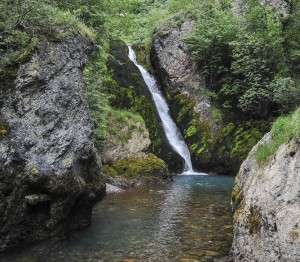
Drini Bardhe near Peja. | Photo: Atdhe Mulla
When you drive around Kosovo it becomes abundantly clear how much men dominate public life. Go into any town or village, and guys will be hanging around, a few of whom will happily speak to a journalist. Women, particularly younger ones, are a far less frequent sight.
I decided that the best place in Western Kosovo to talk to women would be Peja, the fourth largest municipality in Kosovo and known for the machismo of its men. It is also the birthplace of Majlinda Kelmendi, the judo star who competed in last summer’s Olympics, in London.
The steak tava that I ate at Kulla e Zenel Beut was exceptional, among the best I’ve had in Kosovo.
A colleague from Peja arranged for me to have dinner with two of her friends, Zana Kabashi, 17, and Ejona Prelvukaj, 18, both of whom recently graduated high school. At their suggestion, we ate at Kulla e Zenel Beut, a traditional restaurant housed in a kulla.
They both plan to attend the University of Prishtina in the fall, to study electrical engineering and accounting, respectively. They are among the first generation of Kosovars with no personal memory of the war. What struck me was how honest they were about Kosovo’s problems and how optimistic they are about the future.
“We need people who can make this a better place,” Kabashi said.
Neither has ever voted and both are ready for political change. “We’ve had the same group of people in power for 20 years and haven’t gotten anywhere,” Kabashi said.
In their spare time, Prelvukaj and Kabashi have helped revive Peja’s cinema, which is now showing movies regularly after being dormant for years, and have ambitious plans for their own futures.
Prelvukaj was named after her family’s business, which repairs escalator and elevators. She works as an accountant there and hopes to take it over one day – an idea that she says her parents support.
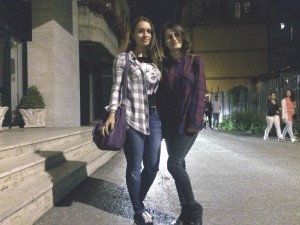
Ejona Prelvukaj, 18, and Zana Kabashi, 17, just graduated high school in Peja and have high hopes for their futures. | Photo: Atdhe Mulla
In Kosovo, where women frequently are cut out of their inheritance, Prelvukaj’s ambitions are unusual and refreshing. “My brother is more into art, anyway,” she joked.
Also encouraging was Prelvukaj and Kabashi’s taste in food. The steak tava — a traditional dish of meat and vegetables cooked in a clay casserole — that I ate at Kulla e Zenel Beut was exceptional, among the best I’ve had in Kosovo.
Kulla e Zenel Beut is north of the Lumbardhi River on William Walker Street, near Wesley Clark Street. Contact: +386 49 400 046.
*This article was initially published in 2015 in the July 3- 16 print issue of Prishtina Insight. To browse seven years of Prishtina Insight online, click here to become a subscriber.





